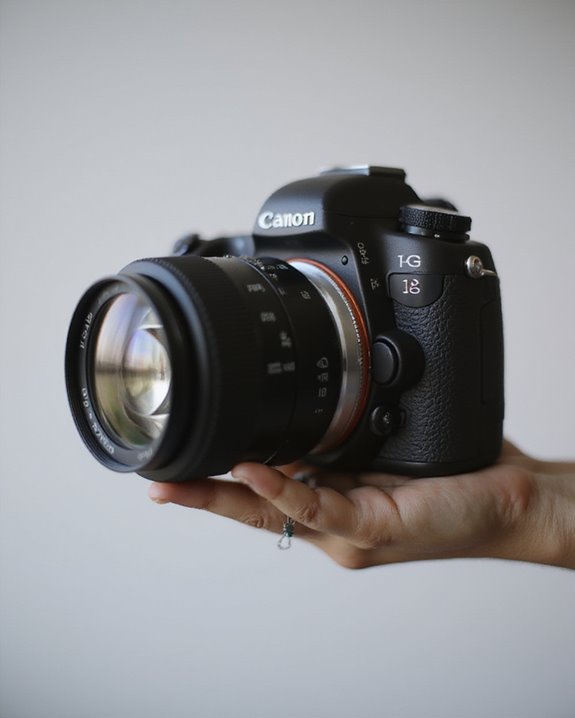Cleaning an iPhone camera lens requires gentle wiping with a clean microfiber cloth using circular motions to remove fingerprints and dust. For stubborn smudges, slightly dampen the cloth with distilled water or lens solution, never applying liquid directly to the lens. Avoid paper towels, household cleaners, and compressed air, as these can damage the lens coating or force debris into the camera mechanism. Regular maintenance prevents permanent scratches and guarantees consistently sharp, clear photos with accurate colors.
Key Takeaways
- Use a microfiber cloth with gentle circular motions to safely remove smudges without scratching the lens surface.
- Begin with a rocket air blower to remove loose dust particles before wiping the lens.
- For stubborn smudges, lightly dampen the microfiber cloth with lens cleaner or distilled water.
- Power off your iPhone before cleaning to prevent accidental camera activation and potential damage.
- Avoid household cleaners, compressed air, and paper towels which can damage lens coatings.
Why Regular Iphone Camera Lens Cleaning Matters
Why do professional photographers always maintain spotless equipment? They understand that cleanliness directly impacts image quality. The same principle applies to iPhone cameras, where even minor smudges greatly degrade photo results. Regular lens cleaning prevents blurry images, color distortion, and reduced sharpness caused by accumulated dirt and fingerprints. When dust and oils obstruct the lens, the camera’s autofocus system struggles to perform ideally, resulting in slower focusing and impaired low-light capabilities. Additionally, consistent maintenance contributes to device longevity by preventing permanent scratches from abrasive particles and protecting the lens coating from degradation over time. Proper cleaning also helps preserve the lens coatings that enhance image clarity and reduce glare. Beyond technical benefits, clean lenses guarantee professional-quality output for social media sharing and content creation while simultaneously promoting better device hygiene, reducing bacterial transfer and allergen accumulation during regular use.
Essential Cleaning Supplies for Your Iphone Lens
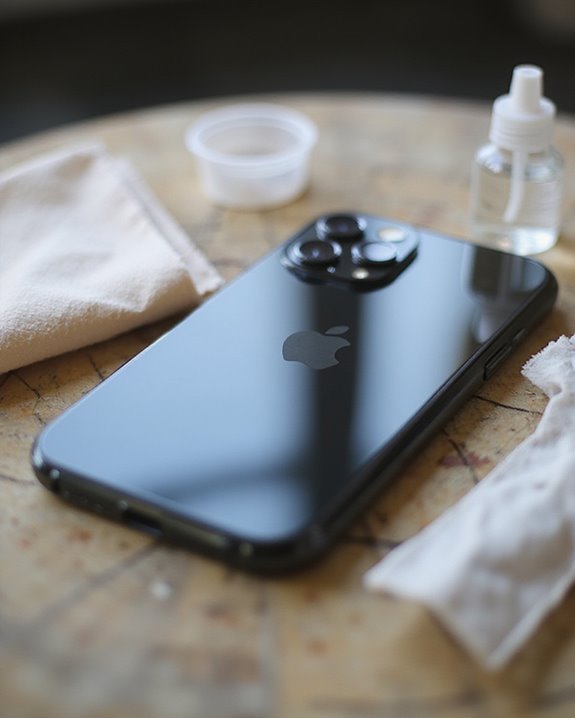
The right cleaning supplies form the foundation of effective iPhone camera maintenance, making the difference between mediocre and exceptional photo quality. Ideal fabric selections include microfiber cloths and lens-specific tissues like Kimwipes, which remove smudges without scratching delicate surfaces, unlike standard tissues or paper towels that can cause micro-abrasions. Using microfiber cloths that are individually-wrapped helps prevent cross-contamination and ensures a lint-free cleaning process. For stubborn grime, appropriate liquid varieties become necessary components of any cleaning regimen. Professional lens cleaners, formulated specifically for optical equipment, protect anti-glare coatings while dissolving oils. These solutions should be applied to the cloth rather than directly to the lens. For particle removal, rocket air blowers offer safe dust elimination without contact. Combining these tools with protective accessories such as lens caps creates a thorough maintenance system that preserves image clarity and extends camera functionality.
Quick Daily Maintenance for Crystal Clear Photos
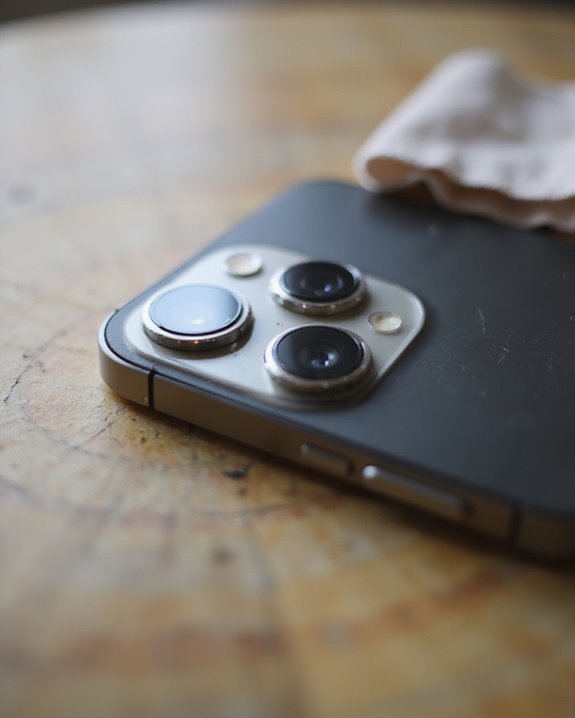
While having the right cleaning supplies creates a foundation for pristine iPhone photos, establishing a quick daily maintenance routine actually prevents the need for deep cleaning sessions. Habit formation around lens care guarantees ideal image quality with minimal effort. Experts recommend inspecting the camera lens daily for smudges or debris, then gently wiping with a microfiber cloth using circular motions. Incorporating lens cleaning kits into your routine ensures safe and effective maintenance without risking damage to delicate coatings. Routine integration of lens maintenance into daily activities, such as checking before taking the day’s first photo, proves highly effective. Users should avoid compressed air and harsh chemicals that damage lens coatings, opting instead for soft brushes to remove particles when necessary. Keeping the iPhone in a protective case when not in use greatly reduces dust accumulation and scratch risk, preserving the camera’s clarity and functionality over time.
Step-by-Step Deep Cleaning Process
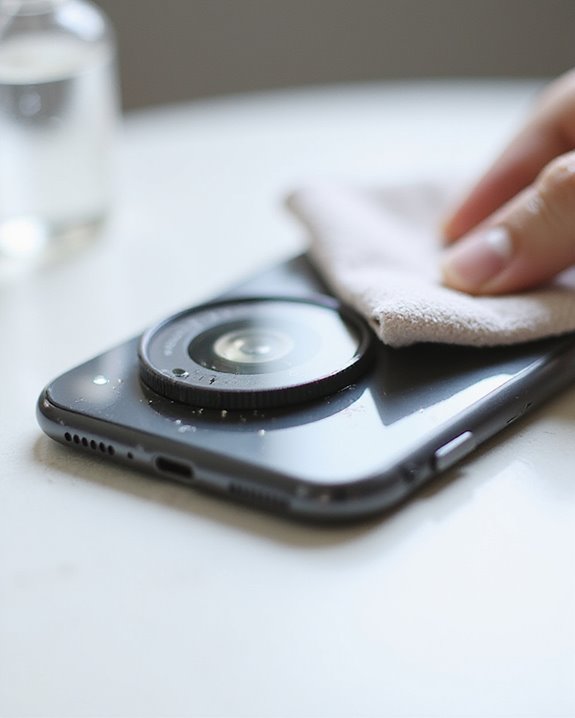
Executing a thorough deep cleaning process for iPhone camera lenses requires five distinct steps, beginning with proper preparation of both the device and cleaning materials. First, power off the device and inspect the lens under bright light to identify contaminants. Second, employ Air Blowing techniques using compressed air in short bursts to dislodge loose particles without touching the lens. Third, proceed with Cloth Wiping using a microfiber cloth in gentle circular motions, first dry and then slightly dampened if necessary. Fourth, address stubborn residue with specialized tools such as lens pens or microfiber brushes, carefully working around the lens edges. Finally, conduct post-cleaning verification by inspecting the lens under light and taking test photos to confirm ideal camera performance.
Removing Stubborn Fingerprints and Smudges
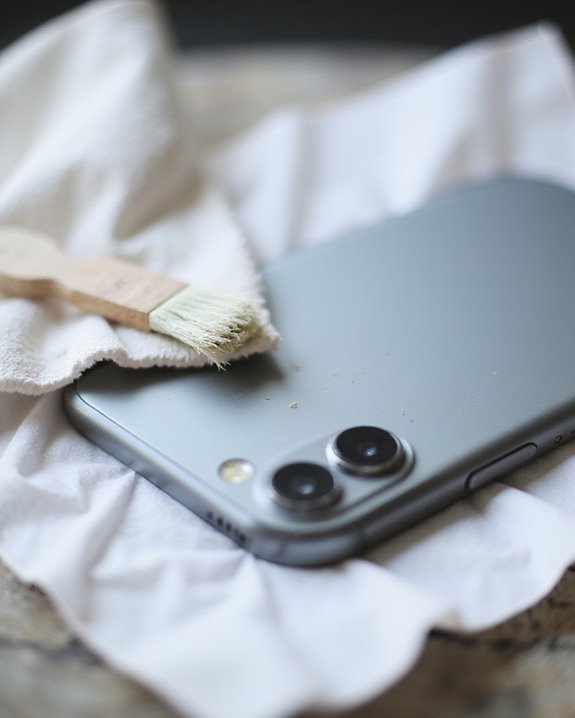
Fingerprints and smudges represent common challenges for iPhone camera performance, often requiring specialized techniques beyond basic cleaning methods. Natural solutions like a slightly damp microfiber cloth provide effective cleaning without risking damage to sensitive lens surfaces, particularly when household cleaners might harm special coatings. For exceptionally stubborn smudges, innovative tools such as lens cleaning wipes specifically designed for camera optics can remove residue without leaving lint behind.
Prevention remains the most efficient strategy, with regular maintenance using clean hands greatly reducing smudge accumulation. When fingerprints persist, users should avoid compressed air or sharp objects that might damage the lens, opting instead for gentle lifting motions with non-metallic implements. For protected lenses, a low-heat hairdryer can safely loosen adhesive when removal becomes necessary.
Dealing With Dust Around Lens Edges
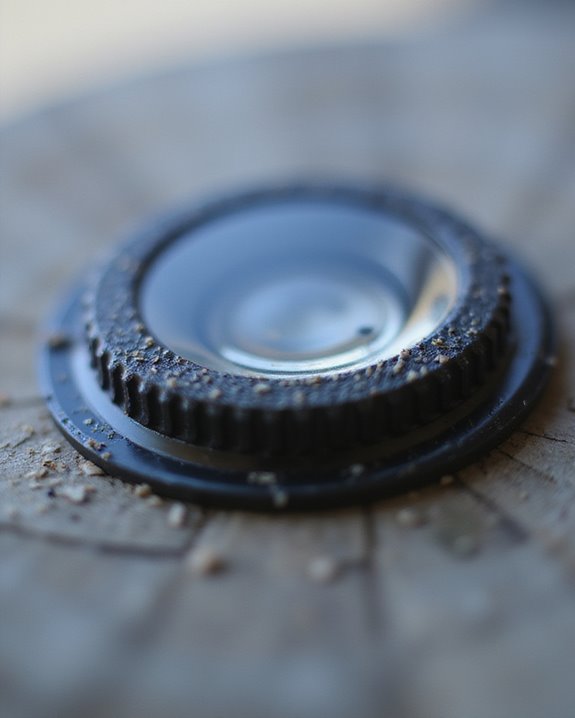
Inspecting the delicate edges of your iPhone camera lens reveals a common nemesis: dust particles that accumulate in the narrow crevices and gaps around the lens housing. This stubborn debris requires specialized tools and careful techniques for effective removal without damaging sensitive components.
A rocket blower provides the first line of defense, using controlled air pressure to dislodge loose particles while preventing them from resettling on the lens. For persistent debris, specialized gel cleaners can safely lift dust from tight spaces without leaving adhesive residue behind. Advanced users might employ UV detection techniques after cleaning to reveal any remaining particles requiring attention.
Regular maintenance prevents significant buildup, with weekly rocket blower sessions and monthly deep cleaning using proper tools rather than abrasive clothing fibers that can introduce oils and scratches to the lens surface.
Common Mistakes That Damage Iphone Camera Lenses
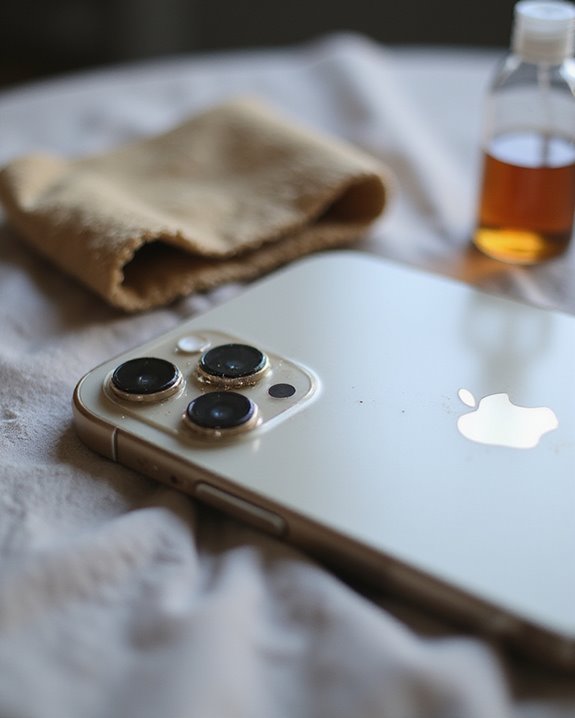
While mastering the proper techniques for dust removal is valuable, many iPhone users inadvertently cause damage to their camera lenses through several common mistakes. These Cleaning Errors include using household cleaners containing harsh chemicals like bleach or ammonia, which degrade protective lens coatings, and applying alcohol-based solutions not specifically formulated for camera optics. Paper towels and contaminated shirt fabric can introduce micro-scratches when particles become trapped against the glass surface.
Pressure Risks represent another significant concern, as bending phone frames during overzealous cleaning can misalign delicate camera modules. Heavy-handed wiping or aggressive circular motions may grind particles into the lens rather than removing them. Additional damage occurs when users neglect peripheral components like the flash and adjacent microphone ports, where accumulated debris can migrate to the lens surface.
Protective Measures to Keep Your Lens Clean Longer
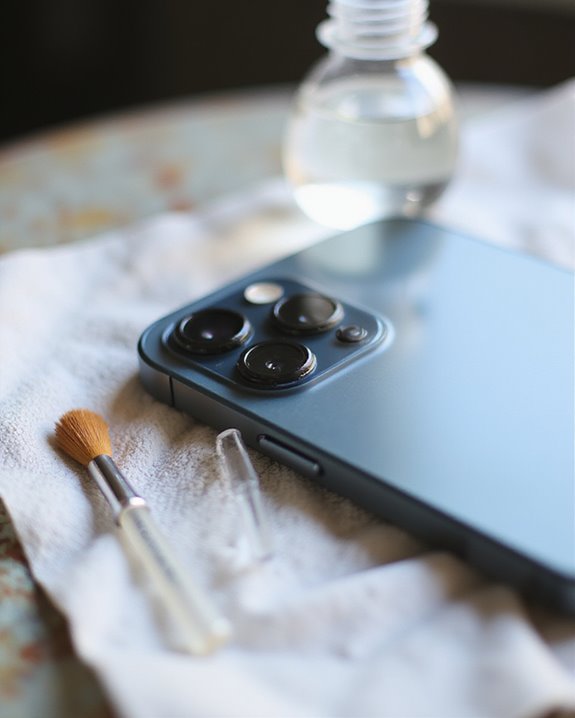
Protecting your iPhone camera lens from damage requires more than just proper cleaning techniques—it also demands preventative measures to maintain optical clarity over time. High-quality tempered glass protectors with 9H hardness provide excellent scratch and impact resistance while preserving image quality. These protectors, typically 0.3mm thick, avoid interference with photography while offering substantial protection.
Brands like OMOTON and Belkin manufacture premium lens protectors featuring oleophobic coating, which repels fingerprints and oils that commonly accumulate on camera surfaces. This specialized coating reduces the frequency of cleaning needed, extending periods between maintenance. When selecting a protector, users should verify compatibility with their specific iPhone model and confirm the product features case-friendly designs that work seamlessly with protective phone cases, preventing installation complications or camera function interference.
When to Seek Professional Cleaning Services
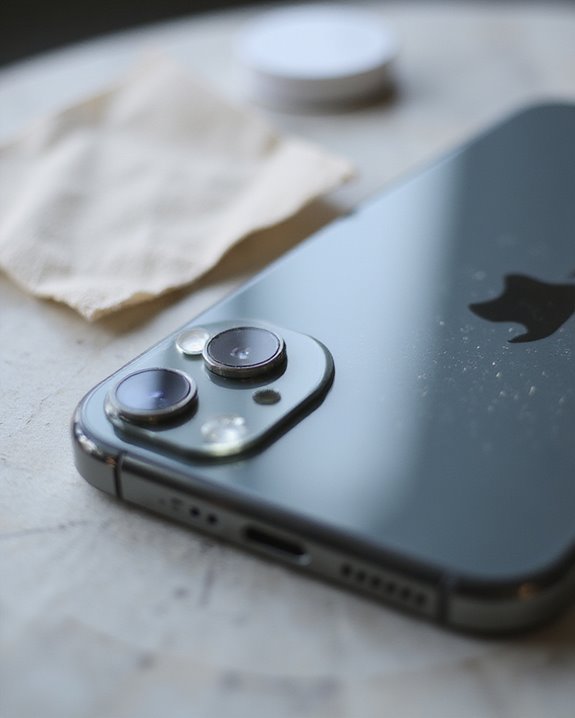
Despite diligent maintenance efforts, iPhone camera lenses sometimes require professional intervention when standard cleaning methods prove insufficient. Users should consider Expert Consultation when persistent image artifacts appear across multiple photos, particularly dark spots or consistent blurring that remains after gentle cleaning attempts. Physical indicators warranting professional attention include visible scratches affecting image clarity, dust accumulation inside multi-lens arrays, or loose components producing rattling sounds.
Addressing these issues independently introduces significant Warranty Risks, as DIY repairs may void AppleCare+ coverage or damage specialized lens coatings. Professional technicians possess specialized tools—including sensor swabs and antistatic brushes—unavailable to consumers. Apple-authorized service providers offer calibration capabilities essential for multi-lens alignment following deep cleaning, especially after exposure to saltwater, sand, or chemicals that necessitate partial disassembly of camera components for proper restoration.
Troubleshooting Persistent Camera Quality Issues
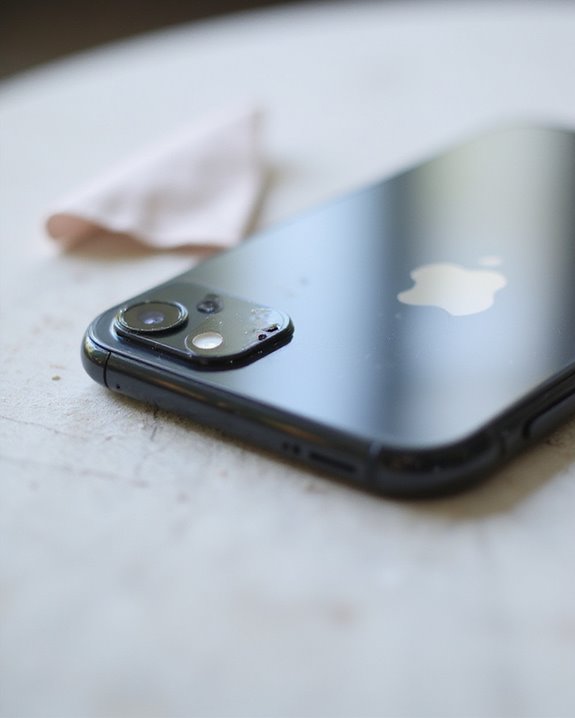
Persistent camera quality issues often frustrate iPhone users who have already attempted basic cleaning procedures. When standard lens cleaning fails to resolve blurry or unfocused images, users should investigate other potential causes. Software glitches, often resolved through iOS updates, can greatly impact focusing capabilities and overall image quality. Users experiencing ongoing problems should verify their device’s operating system and camera application are current.
Hardware malfunctions represent more serious concerns that cleaning cannot address. Damaged autofocus motors, compromised optical image stabilization systems, or cracked lenses require professional intervention. Users should examine their device for signs of physical damage resulting from drops or impacts. Additionally, extreme temperature exposure can temporarily or permanently affect internal camera components. For issues persisting after cleaning and software updates, Apple’s diagnostic services offer thorough assessment of potential hardware failures.
Frequently Asked Questions
Can Isopropyl Alcohol Damage the Iphone Camera’s Oleophobic Coating?
Isopropyl alcohol can damage the iPhone camera’s oleophobic coating. Solvent alternatives like microfiber cloths provide safer cleaning options. Coating durability is compromised when exposed to harsh chemicals, potentially affecting lens performance and clarity.
How Often Should I Replace My Microfiber Cleaning Cloths?
Microfiber cloth durability varies with usage intensity. Generally, replacement is recommended every 3-6 months or when visible degradation occurs. Signs indicating replacement include persistent streaking, fraying fibers, stiffness, or visible contamination despite washing.
Will a Screen Protector Affect Photo Quality or Cause Lens Flare?
Screen protectors can affect photo quality if they have excessive protector thickness or edge bubbles. These issues may cause light distortion or lens flare, especially when the protector extends over the camera lens area.
Can Humidity or Temperature Changes Cause Internal Lens Condensation?
Potentially problematic, humidity heightens the risk of internal lens condensation. Temperature impacts intensify this effect, as sudden shifts create ideal conditions for moisture to accumulate inside camera lenses, compromising image clarity and device function.
Does Using the Camera Underwater Require Special Cleaning Afterward?
After underwater usage, special cleaning is essential. Salt removal prevents corrosion on iPhone camera lenses. Thorough drying and gentle wiping with a microfiber cloth maintains waterproof integrity and prevents mineral buildup on optical surfaces.


